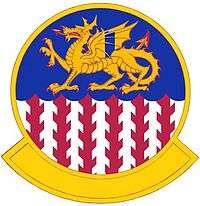337th Test and Evaluation Squadron
| 337th Test and Evaluation Squadron | |
|---|---|
|
Insignia of the 337th Test and Evaluation Squadron. Approved 29 August 1967. | |
| Active |
1942 - 1945 1947 - 1949 1953 - 1994 2004 - |
| Country | United States |
| Branch | United States Air Force |
| Part of |
Air Combat Command (ACC) 53d Wing |
| Garrison/HQ | Dyess AFB, TX |
| Equipment | B-1 Lancer |
| Decorations |
|

The 337th Test and Evaluations Squadron is a squadron of the United States Air Force. It is a part of the 53d Test and Evaluation Group of the 53d Wing. Its primary task is to test and evaluate modifications on the B-1 bomber, as well as to train future aircrews to fly upgraded B-1s.[1] The 337th is headquartered at Dyess AFB, Texas, though it operates out of a number of bases throughout the United States.[2]
History
From 14 May 1943 to 21 April 1945, the squadron conducted strategic bombardment of shipyards, submarine bases, marshaling yards, oil facilities, airfields, and aircraft plants. On occasion, it flew tactical sorties against gun emplacements, rocket sites, enemy troops, and communications centers.
On 17 August 1943, it earned its first Distinguished Unit Citation (DUC), striking targets at Regensburg and Schweinfurt, Germany. Soon after, on 14 October 1943, the squadron participated in World War II's single most important raid on ball-bearing factories at Schweinfurt.
On 9 April 1944, it earned a second DUC in an attack on aircraft component factories at Poznań, Poland. The squadron subsequently attacked enemy field batteries and miscellaneous targets in support of Normandy operations on 6 June 1944.
Beginning in 1968, B-52 aircraft and crews deployed to Southeast Asia (SEA) for bombardment operations. For much of the conflict, the squadron furnished aircraft and crews to SAC organizations based in SEA. When the Air Force switched to the B-1 Lancer, the 337th was the first unit to fly the new bomber.
As part of the 53d Test and Evaluation Group, the 337th conducts testing of various upgrades to the B-1, as well as trains aircrews to operate and maintain the upgraded aircraft. The squadron has been currently working on the increasing the B-1's weapons payload, attempting to increase the bomber's ability to deliver weapons into heavily defended areas.[1]
Lineage
- Constituted 337th Bombardment Squadron (Heavy) on 28 January 1942.
- Activated 15 July 1942.
- Redesignated 337th Bombardment Squadron, Heavy on 22 June 1943.
- Inactivated 29 November 1945.
- Redesignated 337th Bombardment Squadron, Very Heavy on 13 May 1947
- Activated in the Reserve on 29 May 1947.
- Inactivated 27 June 1949.
- Redesignated 337th Bombardment Squadron, Medium on 6 November 1953
- Activated 18 November 1953.
- Discontinued, and inactivated, on 15 March 1963.
- Redesignated 337th Bombardment Squadron, Heavy.
- Activated 20 March 1963.
- Organized 15 September 1963.
- Redesignated 337th Bomb Squadron on 1 September 1991.
- Inactivated 1 October 1994.
- Redesignated 337th Test and Evaluation Squadron on 8 April 2004.
- Activated 14 May 2004.
Stations, Assignments, & Aircraft
| Date | Base | Assignment | Aircraft |
|---|---|---|---|
| 15 July 1942 | Salt Lake City Army Air Base, Utah | 96th Bombardment Group | B-17 Flying Fortress |
| 6 August 1942 | Gowen Field, Idaho | ||
| 31 August 1942 | Walla Walla Army Air Base, Washington | ||
| 29 September 1942 | Rapid City Army Air Base, South Dakota | ||
| 3 November 1942 | Pocatello Army Airfield, Idaho | ||
| 7 January - 15 April 1943 | Pyote Army Air Base, Texas | ||
| 13 May 1943 | RAF Andrews Field (AAF-485), England | ||
| 29 May 1943 - 22 November 1945 | RAF Snetterton Heath (AAF-138), England | ||
| 27–29 November 1945 | Camp Kilmer, New Jersey | ||
| 29 May 1947 - 27 June 1949 | Gunter Field (later AFB) Alabama | T-6 Texan AT-11 Kansan | |
| 18 November 1953 | Altus AFB, Oklahoma | 96th Bombardment Wing | B-47 Stratojet |
| 8 September 1957 - 15 March 1963 | Dyess AFB, Texas | ||
| 15 September 1963 - 1 October 1994 | Dyess AFB, Texas | 20 March 1963 — Strategic Air Command 15 September 1963 — 96th Operations Group 1 October 1993 - 1 October 1994 — 7th Operations Group |
B-52 Stratofortress (until 1985) |
| B-1 Lancer (after 1985) | |||
| 14 May 2004–present | Dyess AFB, Texas | 53d Test and Evaluation Group |
Decorations
Distinguished Unit Citations
- Germany, 17 August 1943
- Poznań, Poland, 9 April 1944
Air Force Outstanding Unit Awards
- 1 January 1959 - 31 December 1960
- 1 July 1974 - 30 June 1975
- 1 July 1978 - 30 June 1979
- 1 July 1988 - 30 June 1990
- 1 July 1990 - 29 May 1992
- 1 June 1992 - 30 May 1994
See also
References
- 1 2 Unit: 337th Test and Evaluation Squadron. USAFEngineers.com. Accessed: 3 November 2007.
- ↑ 53rd Wing official website. Accessed: 3 November 2007
![]() This article incorporates public domain material from the Air Force Historical Research Agency website http://www.afhra.af.mil/.
This article incorporates public domain material from the Air Force Historical Research Agency website http://www.afhra.af.mil/.
- Maurer, Maurer, ed. (1983) [1961]. Air Force Combat Units of World War II (PDF) (reprint ed.). Washington, DC: Office of Air Force History. ISBN 0-912799-02-1. LCCN 61060979.
- Maurer, Maurer, ed. (1982) [1969]. Combat Squadrons of the Air Force, World War II (PDF) (reprint ed.). Washington, DC: Office of Air Force History. ISBN 0-405-12194-6. LCCN 70605402. OCLC 72556.
